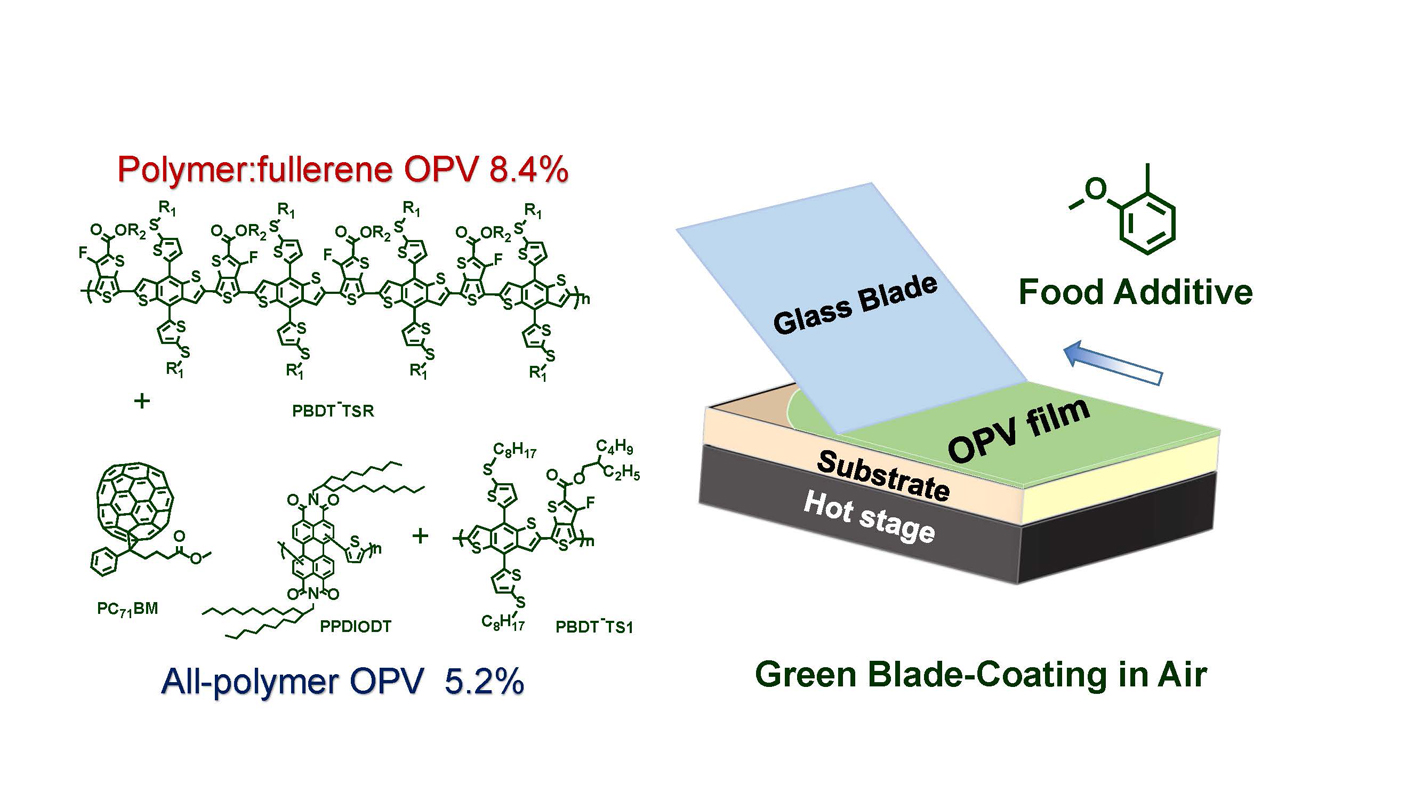Food Additive Key to Environmentally Friendly, Efficient, Plastic Solar Cells

For Immediate Release
Researchers from North Carolina State University and the Chinese Academy of Sciences have created an efficient, semi-printed plastic solar cell without the use of environmentally hazardous halogen solvents. These solar cells can be manufactured at room temperature, which has implications for large-scale commercial production.
Plastic solar cells, or organic photovoltaics, are popular because they are lightweight, flexible, transparent and inexpensive to manufacture, making them useful in multiple applications. Unfortunately, the halogen-containing solvents used in their manufacture are an obstacle to large-scale commercialization. These solvents are key to making sure that the solar cell’s morphology, or structure, maximizes its energy efficiency; however, they are environmentally hazardous. Additionally, the use of these harsh chemicals requires a controlled environment, which adds to production costs.
Long Ye, a postdoctoral research scholar in physics at NC State and lead author of a paper describing the work, wanted to find out if nontoxic solvents could provide equally efficient morphology in the manufacturing process. Ye and his colleagues developed a proof of concept semi-printed plastic solar cell that utilized o-methylanisole (o-MA) as the solvent. O-MA is a commonly used flavoring agent in foods, and is nontoxic to humans.
The researchers used soft X-ray techniques to study the morphology of their solar cell. They found that the o-MA based solar cell had similar morphology, crystalline features and device performance to those produced by halogenated solvents. The solar cell’s overall efficiency rating was around 8.4 percent. Furthermore, their cell could be produced via blade coating at ambient, or room temperature. Blade coating is a process that uses a glass blade to spread a thin layer of the photovoltaic film onto either a rigid or flexible substrate, and the process is compatible with large-scale commercial manufacturing.
“Two of the key requirements for mass producing these solar cells are that the cells can be produced in the open air environment and that the process doesn’t pose health or environmental hazards,” Ye says. “Hopefully this work can help pave the way for printing solar cells in ambient air.”
The work appears in Chemistry of Materials. NC State physicist Harald Ade is corresponding author, and Chinese Academy of Sciences professor Jianhui Hou is co-corresponding author. Ade group member Yuan Xiong fabricated the solar cell, with Brendon T. O’Connor and Abay Gadisa contributing to the work. Funding was provided by the Office of Naval Research grant N0014-15-1-2322 and UNC-GA Research Opportunity Initiative grant.
-peake-
Note to editors: An abstract of the paper follows.
“High Performance Organic Solar Cells Processed by Blade Coating in Air from a Benign Food Additive Solution”
DOI: 10.1021/acs.chemmater.6b03083
Authors: Long Ye, Yuan Xiong, Abay Gadisa, Masoud Ghasemi, Adrian Hunt, Nrup Balar, Brendan T. O’Connor and Harald Ade, North Carolina State University; Huifeng Yao, Hao Zhang, Sunsun Li, and Jianhui Hou, Chinese Academy of Sciences
Published: Online in Chemistry of Materials
Abstract:
Solution processable conjugated organic materials have gained tremendous interest motivated by their potential of low cost, light weight and especially easy manufacturing of large-area and flexible electronics. Toxic halogen-containing solvents have been widely used in the processing of organic electronics, particularly organic photovoltaics (OPVs). To transition this technology to more commercially attractive manufacturing approaches, removing these halogenated solvents remains one of the key challenges. Our morphological (hard/soft X-ray scattering) and calorimetric characterizations reveal that using o-methylanisole, a certified food additive, as processing solvent can achieve similar crystalline properties and domain spacing/purity with that achieved by widely used binary halogenated solvents (chlorobenzene and 1,8-diiodooctane), thus yielding comparable photovoltaic performance in spin-casted films. To move a step forward, we further present the potential of o-methylanisole as processing solvent in the blade-coating of several cases of OPVs in air. Remarkably, this single nonhazardous solvent yields ~8.4% and ~5.2% efficiency in OPVs by respectively blade-coating PBDT-TSR:PC71BM and all-polymeric PBDT-TS1:PPDIODT in ambient air, which are among the highest values for the same kind of devices. We believe this simple non-hazardous solvent approach will also be applicable in the large area roll-to-roll coating and industrial scale printing of high-efficiency OPVs in air.
- Categories:


